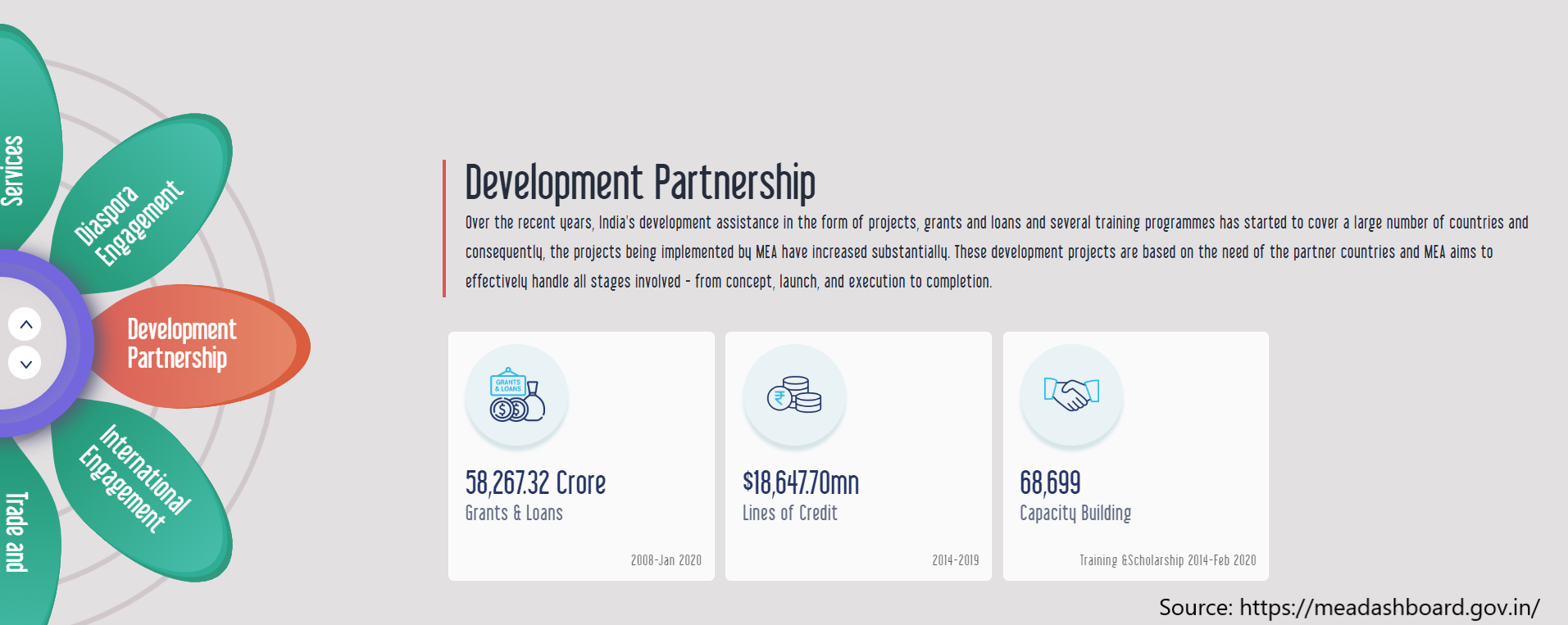By Rachna Shanbog (DCU)
“We believe that data empowers people. It is our intention to give more power to the people and to respond to their needs in an efficient and transparent manner by being at the forefront of bringing accountability and accessibility to them” said External Affairs Minister, S. Jaishankar, launching the ‘Performance Smart Board’ in August 2019. This is a much-needed online space, not just to showcase the work of the Ministry of External Affairs (MEA), but also to promote transparency, especially with regard to India’s development assistance programme. However, the information on the webpage needs to be improved upon. This post sets out a number of recommendations to make this fairly new space more useful, comprehensive, and intriguing for not just practitioners and researchers, but also for others who might be interested in knowing more about it.
Incorporation of data from before Modi era
According to Minister Jaishankar’s speech, the smartboard integrates ‘three types of dashboards – operational (for monitoring in real-time), tactical (for analysis and benchmarking) and, strategic (for tracking the achievement of strategic objectives)’. To do so, this information management tool categorises the data into five broad categories: Citizen Services; Development Partnership; Diaspora Engagement; International Engagement and; Trade & Commerce. The components included under this programme in this smartboard are Grants and Loans, Lines of Credit (LoCs), and Capacity Building. These data need to be updated and expanded upon. The information as it stands now on the website gives the impression that LoCs and Capacity Building programmes were initiated only after 2014.
Information on India’s Capacity Building programme is only from 2014 onwards, which is disappointing considering it has been one of the oldest forms of assistance that India has provided. Indian Technical and Economic Cooperation began in 1964, Indian Council for Cultural Relations as an institution was founded in 1950, and India-Africa Forum Summit Training and Scholarships were initiated in 2008. Similarly amounts under LoC is from 2014 onwards, even though Exim Bank has data from 2002 onwards. Furthermore, it is unclear whether the data provided on LoC concerns the amount committed by the Government of India (GoI) or what has been disbursed so far. This will hopefully be updated soon and will not be restricted to the governing period under Modi. At present (end of April 2020), the Grants and Loans data is from 2008 to 2020 on both ‘funds allocated’ and ‘funds disbursed’.
Giving visibility to humanitarian aid
Humanitarian aid provided by India is not accounted under development partnerships at present. Nevertheless, the smartboard could include ‘Humanitarian aid’ as a category to highlight the material and logistic assistance that India has provided to countries in urgent need in the wake of disasters. Mawdsley (2010, p. 366), quoting various writers on the components of the aid programme, states “Agrawal, for example, notes that – what India calls overseas development assistance is often a mixed bag of project assistance, purchase subsidies, lines of credit, travel costs, and technical training costs incurred by the Indian government”, adding humanitarian assistance to this will only highlight the support that the country has been providing to disaster-hit states.
Defining aid components
Like most countries which follow the South-South Development Cooperation (SSDC) principles, India does not have a set definition on grants and loans. MEA’s annual reports do indicate, however, that loans are largely concessional in nature. Unlike the OECD-DAC definition on concessional loans, the GoI does not define how much concession it provides and what terms are followed for concessional loans. In contrast, LoCs, which are managed by Exim Bank under the Ministry of Finance has laid out a detailed process that is followed by GoI while providing credit. With respect to the Capacity Building programme components, each of the institutions in charge of the scholarships have well-defined frameworks in place.
Detailing project data and enhancing monitoring mechanisms
As a step forward, each country could be linked on the website to the respective Indian Embassy/High Commission website, breaking down the data into projects that are supported by India in recipient countries and providing further details on achievements and learning so far, highlighting both quantitative and qualitative data. Another possibility would be to add more pages to the existing website and give more country-specific details, similar to the presentation of information on the ASEM Sustainable Connectivity Portal.
The dashboard at present reflects data for each of the countries/regions. The above suggestions would not only help in monitoring but would also serve to support enhanced government analysis and benchmarking. In addition, respective Indian offices in recipient countries could also upload grant agreements, loan details and other documents signed between the two countries. These sets of documents are not currently publicly available, and if made accessible could improve the transparency of India’s overseas development activities.
Further enhancement of India’s approach to overseas development will necessitate elucidation of its development assistance policy and country-specific agendas. In addition to this, a repository of these documents can be useful to everyone. Without such a documented blueprint, only those who were in power when developing a particular project will know what the intended project support was meant to achieve.
The MEA smartboard is a good beginning and serves two purposes: in a democracy such as India, it enhances financial transparency and accountability to its citizens; and at the same time provides a platform for showcasing India’s ODA programme. But with the current information that is on the website, it is still necessary to use tools like the Right to Information Act, 2005 (in India) to obtain full details. Incorporating some of the above suggestions can set an example for other donors to follow.

